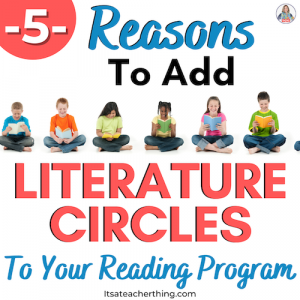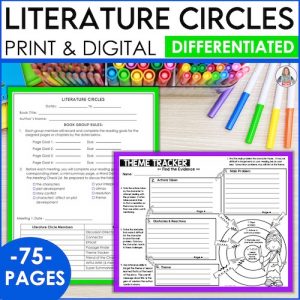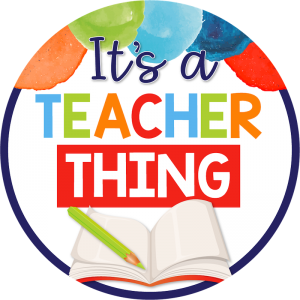Literature circles in the classroom are the perfect addition to any reading program. Learn 5 of the best reasons to start using literature circles today!

Literature circles: 5 great reasons to add them to your upper elementary or middle school classroom:
- Literature circles can easily engage all students.
- Literature circles teach etiquette.
- Literature circles provide an opportunity for positive peer interaction.
- Literature circles inspire students to think at a deeper level.
- Literature circles help students become better readers.
Read on for more detail.
Literature circles offer a way for all students to engage at a higher level
Each meeting, I see students engage on deeper levels, risking a bit more, thinking aloud and questioning their own ideas as well as the ideas of their peers. The expectation that all students will participate and the support I offer to help all readers feel like they have something to add can be a confidence builder. This doesn’t happen as often with independent reading novels.
Students learn etiquette during literature circles in the classroom
Kids need reminders that the rules of behavior change depending on the setting. I keep literature circles a bit more formal, and students feel the shift in expectation. I serve tea and small treats. It’s funny how such a simple thing as drinking a cup of tea can change the feeling of the setting. This intentional component offers me the opportunity to discuss manners like sipping your drink, eating with your mouth closed, not talking with food in your mouth.
You might think “What is she doing teaching manners in the classroom?” Honestly, there are students who don’t have much exposure to etiquette and changing norms for different situations. I’ve come to believe that they really like knowing that their behavior must change (and can change) during literature circle. This sets a more formal tone, and kids really step up to the plate.
Positive peer interaction
I explicitly teach speaking and listening skills before we begin a session of literature circles. I act out what it looks like and sounds like to agree, disagree, express confusion, want more information, etc. This component of literature circles is so important that each student receives a list of speaking stems for support.
Each group gets a copy of the stems, and I display an anchor chart with the stems in the front of the room for extra support. I use a rubric for grading their speaking and listening skills which includes how to sit, eye contact, amount of engagement in conversation, and (for some) limiting the tendency to dominate. These explicit instructions carry over into group work in all other subject areas. What a valuable experience!
Literature circles in the classroom make kids THINK deeply about a novel
When student know they must engage in conversation about a topic, they read more deeply. Even in 6th grade, I regularly have students who’ve never completed a novel or seen the need to think about what they are reading. The hidden power of literature circles is that students must reflect on their reading and then discuss their ideas. Read this post about supporting struggling readers in the classroom. It will help to differentiate literature circles so all students can succeed.
Deep reading skills can be challenging for some students, so I use an interactive packet that supports their thinking. Each student has a group job that changes every meeting, but there’s other work that stays the same. Read this blog post on student roles. Students must complete the reading. If not, their peers will notice and their group won’t function as well. Having peer expectation makes a difference.
Literature circles ask students to summarize main events, note the significance of important passages, connect the novel to other novels, world events, their own lives, identify the importance of setting, point out ethical dilemmas, and so much more! If you want to learn more about close reading, grab this close reading freebie that includes tips and strategies to add even more close reading instruction to your lessons.
Students become better readers
I’m convinced that when students participate in literature circles, they become better readers. Upon completion of a literature circle unit, I notice that students read their next independent novel at a deeper level because they’ve been exposed to and practiced deeper reading.
It’s not uncommon that I get students in August who have never considered that there’s any value or reason to think about a novel. I also believe that many students don’t believe they CAN think deeply about a novel. Literature circles offer many students their first experience with the idea that reading a book can help you see your world differently. What a revelation to learn that words can change your perspective!!
I’ve used my classroom experiences to help create my Literature Circle Unit.
It has everything you’ll need to run literature circles except the novels, and it includes pointers on what to do and what to avoid. For your convenience, I’ve listed many of my favorite literature circle novels as well as the page break down for four meetings.
I have an earlier blog post on making literature circles work in your classroom. Additionally, I was a featured blogger on Rachel Lynette’s Minds in Bloom, where my topic was…Literature Circles! ( you can read it here.)

Save this post for later.

Self-hosted WordPress:
[inlinkz_linkup id=554743 mode=1]
Custom site:




I simply love Teach Like a Pirate; it is an excellent book. When I was a self-self-contained teacher, I used literature circles. I like that you have a resource that can be used with any book. I’m going to share this with my daughters’ Language Arts teachers.
Thanks, Crystal. I find literature circles to be one of the most useful units I do during the school year. And, I’ve begun my collection of costumes for teaching like a pirate!
I love literature circles, too!! And I’m reading Learn Like a Pirate; makes me excited to start back next week, too!! 🙂
I raided my children’s costume box to take items for dressing up in the classroom! (My college-aged kids won’t miss the costumes!)
Really liked Teach like a Pirate. Lots of neat ideas.
Lisa
LisaTeachR’sClassroom
I know. It’s so motivating! I’m going to keep it on my desk.
I love literature circles as well!
The items that you will be adding sound fabulous. So much helpful information. Thanks
The items that you will be adding sound fabulous. So much helpful information. Thanks from Socrates Lantern.